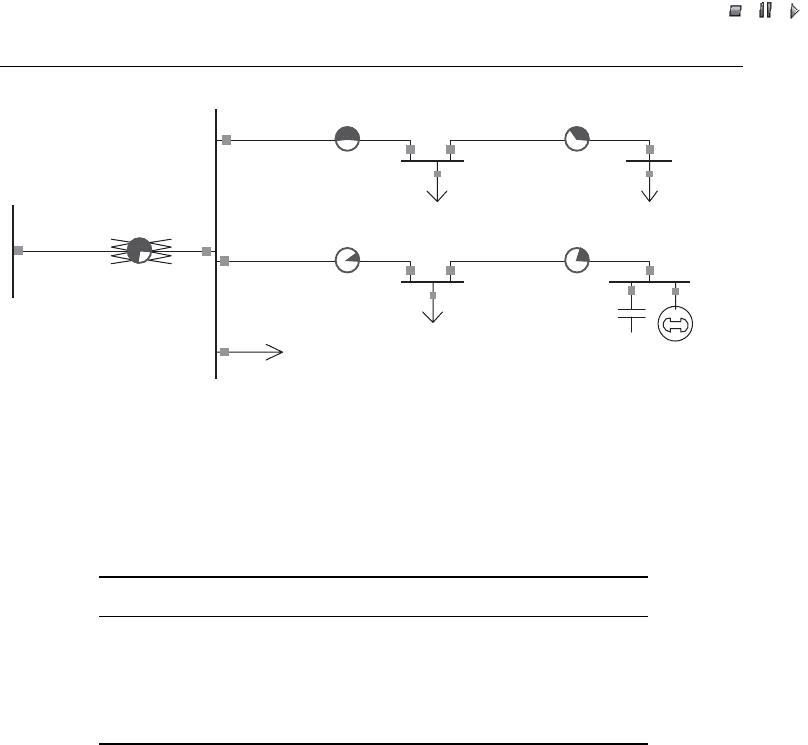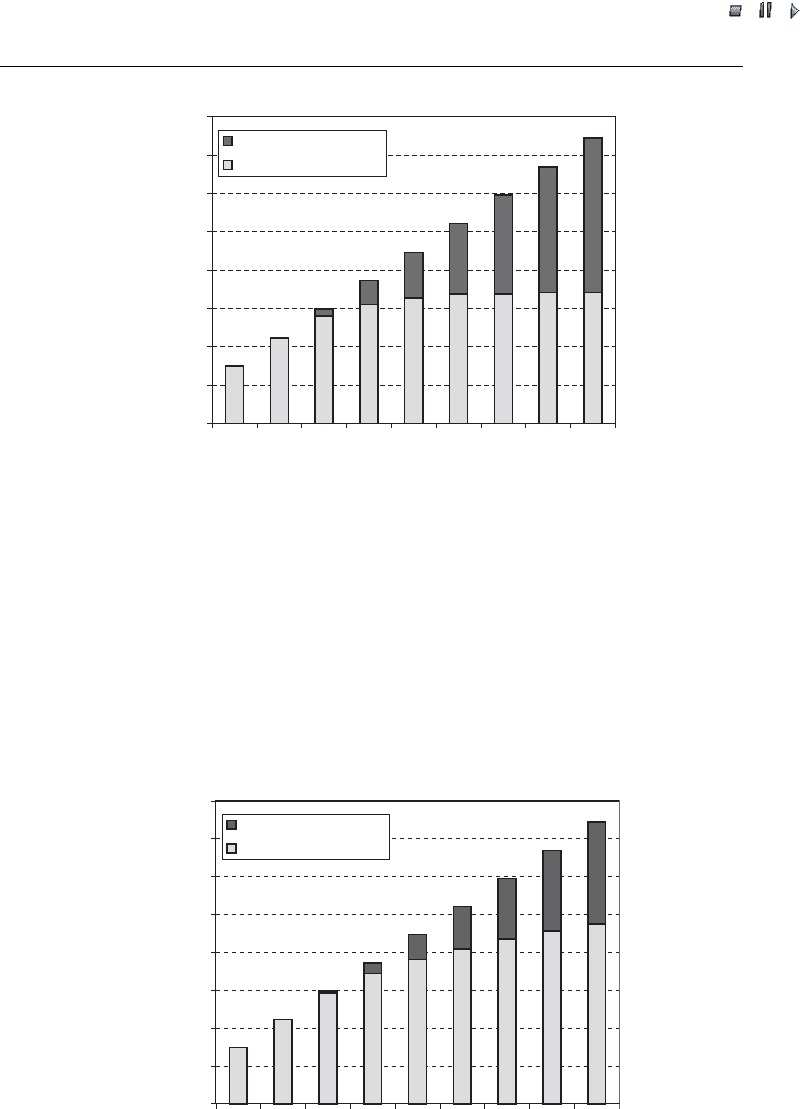AckermannTh. (ed) Wind Power in Power Systems
Подождите немного. Документ загружается.


//INTEGRAS/KCG/P AGIN ATION/ WILEY /WPS /FINALS_1 4-12- 04/0470855088_ 22_CHA21 .3D – 461 – [461–478/18]
17.12.2004 10:44PM
21
Benefits of Active Management
of Distribution Systems
Goran Strbac, Predrag Djapic
´
, Thomas Bopp and Nick Jenkins
21.1 Background
The penetration of distributed generation (DG) and wind power in particular is
expected to increase significantly over the coming years, and a paradig m shift in control,
operation and planning of distribution networks may be ne cessary if this generation is to
be integrated in a cost-effective manner. The transition from passively to actively
managed distribution networks is driven by (a) government environmental commit-
ments to connect a large number of small-scale generation plants; (b) technological
advances in energy generation and storage as well as in information and communication
technologies; (c) regulatory reform and unbundling of the energy industry.
The historic function of ‘passive’ distribution networks is viewed primarily as the
delivery of bulk power from the transmission network to the consumers at lower
voltages. Traditionally, these were designed through deterministic (load flow) studies
considering the critical cases so that distribution networks could operate with a min-
imum amount of control . This practise of passive operation can limit the capacity of
distributed generation that can be connected to an existing system.
In contrast, active management techniques enable the distribution network operator
to maximise the use of the existing circuits by taking full advantage of generator
dispatch, control of transformer taps, voltage regulators, reactive power management
and system reconfiguration in an integrated manner. Active management of distribution
networks can contribute to the balancing of generation with load and an cillary services.
In the future, distribution management systems could provide real-time network moni-
toring and control at key network nodes by communicating with generator controls,
Wind Power in Power Systems Edited by T. Ackermann
Ó 2005 John Wiley & Sons, Ltd ISBN: 0-470-85508-8 (HB)

//INTEGRAS/KCG/P AGIN ATION/ WILEY /WPS /FINALS_1 4-12- 04/0470855088_ 22_CHA21 .3D – 462 – [461–478/18]
17.12.2004 10:44PM
loads and controllable network devices, such as reactive compensators, voltage regula-
tors and on-load tap-changing (OLTC) transformers. State estimation and real-time
modelling of power capability, load flow, voltage, fault levels and security could be used
to make the right scheduling and constraining decisions across the network. These
techniques will probably be applied gradually rather than fulfilling all the above listed
attributes right from the beginning (Bopp et al., 2003).
From a regulator’s perspective, active management should enable open access to
distribution networks. It has the ability to facilitate competition and the growth of
small-scale generation. In addition, the use of the existing distribution assets should be
maximised to minimise the costs for consumer s.
Therefore, an integral understanding of the interrelated technical, economic and
regulatory issues of active management and DG is important for the development of
the future distribution systems (Jenkins et al., 2000).
21.2 Active Management
In this section, the fundamental features of passive distribution networks are examined
and their inability to accommodate increased amounts of DG is discussed. It is demon-
strated how the voltage rise effect, the main limiting factor for connecting generators in
rural areas, can be effectively controlled within an active network environment and, as a
result, enable considerably higher levels of penetration of DG to be connected into
existing systems.
In this chapter, local and area-based coordinated voltage control schemes are dis-
cussed. Qualitative analysis of these alternative schemes is then carried out on a
simplistic distribution network model where the effect of these controls can be easily
understood. It should be noted that the principles described are applicable to DG in
general, not just wind farms.
Distribution network operators prefer to connect DG to higher voltage levels in order
to minimise the impact on the voltage profiles. On the other hand, the developers of DG
favour connections to lower voltage level s since connection costs increase notably with
the voltage level. Active management enables the voltage rise to be mitigated effectively.
Therefore it can have a significant impact on the commercial viability of DG projects
and the level of DG penetration that can be connected to an existing system (Strbac
et al., 2002).
21.2.1 Voltage-rise effect
The voltage rise effect is a key factor that limits the amount of additional DG capacity that
can be connected to rural distribution networks. The impact of DG on the voltage profile
can be qualitatively modelled by means of a simple distribution system representation, as
shown in Figure 21.1 (Liew and Strbac, 2002). The distribution system (DS) is connected
to a 33/11 kV OLTC transformer. The 11 kV voltage side of the OLTC transformer is
connected to busbar 1, which is interconnected to busbar 2 via the impedance (Z)ofan
overhead line. The load, the generation (Gen.) and the reactive compensation device
(Q Comp) are connected to busbar 2. The active and reactive power of the load (P
L
and
462 Benefits of Active Management of Distribution Systems

//INTEGRAS/KCG/P AGIN ATION/ WILEY /WPS /FINALS_1 4-12- 04/0470855088_ 22_CHA21 .3D – 463 – [461–478/18]
17.12.2004 10:44PM
Q
L
, respectively), the generator (P
G
and Q
G
, respectively) and the reactive power of the
reactive compensation device (Q
C
) are marked as arrows in Figure 21.1.
The vo ltage U
2
at busbar 2 can be approximated as follows:
(1)
U
2
U
1
þ RðP
G
P
L
ÞþðQ
G
Q
L
Q
C
ÞX; ð21:1Þ
where X is the reactance.
The impact of active management control actions, the distributed generator, the load,
the OLTC setting U
1
(voltage at busbar 1) and the reactive compensator on the voltage
at busbar 2 (U
2
) can be derived qualitatively from Equation (21.1).
For passively operated distribution networks, the maximum generation capacity that can
be connected can be determined by analysing the worst case. Usually, the highest voltage
rise is expected for the coincidence of maximum generation (P
G
¼ P
max
G
) and minimum
load (P
L
¼ Q
L
¼ 0). For the sake of simplicity, a unity power factor is assumed
( Q
G
Q
C
¼ 0). The voltage for these extreme conditions can be expressed as:
U
2
U
1
þ RP
max
G
: ð21:2Þ
The maximum capacity of generation that can be connected to busbar 2 is limited by the
maximum allowed voltage at busbar 2, U
max
2
. Thi s can be seen from Equation (21.3):
P
max
G
U
max
2
U
1
R
; ð21:3Þ
Another important parameter that de termines the maximum permissible generation
capacity is the resistance, R, of the network impedance, Z. The reactance, X, does not
need to be considered in the formula as long as unity power factor operation of the
generator is assumed. In this context, it should be mentioned that the voltage rise or
drop can be mitigated by reducing the network impedance. This can be achieved by
network reinforcement.
Q
C
P
G
Gen.
Q Comp
Q
G
Z = R + jX
U
1
U
2
33/11 kV
Load
P
L
, Q
L
Bus 1
Bus 2
Distribution
system
OLTC transformer
Figure 21.1 Simple system for voltage-rise modelling. Note: Gen. ¼ generation; OLTC ¼ on-load
tap-changing; Q Comp ¼ reactive compensation device; U
i
¼ voltage at bus i; Z ¼ impedance; R
¼ resistance; X ¼ reactance; P
L
¼ active power of load; Q
L
¼ reactive power of load; P
G
¼ active
power of generator; Q
G
¼ reactive power of generator; Q
C
¼ reactive power of compensation
device; j¼
ffiffiffiffiffiffiffi
1
p
(1)
The convention applied considers flows towards the busbar as positive.
Wind Power in Power Systems 463

//INTEGRAS/KCG/P AGIN ATION/ WILEY /WPS /FINALS_1 4-12- 04/0470855088_ 22_CHA21 .3D – 464 – [461–478/18]
17.12.2004 10:44PM
21.2.2 Active management control strategies
21.2.2.1 Active power generation curtailment
Active power generation curtailment controls the voltage by constraining the active
power of DG to limit the voltage rise (for a detailed description of active management,
see Strbac et al., 2002). Periods when constraints are placed on generation (constraint-on
periods) tend to be relative ly short because of the low probability of the coincidence of
maximum demand and minimum load conditions. Generation curtailment can be
profitable for a distributed generator if, in return, a larger plant capacity can be
connected. The resulting higher output during periods when there are no constraints
can outweigh the monetary impact of the generation curtailment. The price of electricity
during the constraint-on periods is anticipated to be relatively low because these periods
typically coincide with low load conditions. The impact of the curtailed active power
P
curt
G
on the resulting maximum capacity of generation that can be connected, P
max
G
, can
be seen by comparing Equation (21.3) and with Equation (21.4):
P
max
G
P
curt
G
þ
U
max
2
U
1
R
: ð21:4Þ
Given that active power generation curtailment is a local voltage control scheme, this
scheme does not require communication systems.
21.2.2.2 Reactive power management
Particularly in weak overhead distribution ne tworks, reactive compensation can effec-
tively limit the voltage rise and can facilitate the connection of higher generation
capacities. This is possible because of the relatively high reactance of overhead lines
and hence the ability to influence voltage by manipulating reactive flows.
The reactive power absorbed by the network is represented by
Q
import
= (Q
G
Q
L
Q
C
):
The maximum amount of generation capacity that can be connected to the network
under low-load conditions can be expressed as:
P
max
G
ðU
max
2
U
1
Þ
R
þ
Q
import
X
R
: ð21:5Þ
The second term on the right-hand side of the Equation (21.5) quantifies the additional
generation capacity that can be connected compared with that represented by Equation
(21.3). Note that this scheme will not be very effective in urban systems, as the reactance
of underground cables is typically four times smaller than that of overhead lines. Note
also that a decreased power factor leads to an increase in network losses, and therefore
losses have to be included in the assessment for reactive compensation schemes.
Reactive power compensation is a local voltage control scheme that does not need
communication systems.
464 Benefits of Active Management of Distribution Systems

//INTEGRAS/KCG/P AGIN ATION/ WILEY /WPS /FINALS_1 4-12- 04/0470855088_ 22_CHA21 .3D – 465 – [461–478/18]
17.12.2004 10:44PM
21.2.2.3 Coordinated voltage control
Coordinated voltage control with on-load tap changers enables the connection of an
increased capacity of DG by actively changing the OLTC transformer setting an d
maintaining the voltages of a distribution network within defined limits.
The OLTC transformer can regulate the voltage U
1
. The minimum possible value
U
min
1
allows the highest generation capacity P
max
G
to be expressed as follows:
P
max
G
U
max
2
U
min
1
R
: ð21:6Þ
However, in conditions of maximum load and maximum generation it can be beneficial
to separate the voltage control of feeders, which mainly supply load from feeders with a
significant generation. This can be achieved by taking advantage of voltage regulators
on ap propriate feeders. For a complex network configuration, the OLTC transformer
and voltage regulator tap settings can be determined by optimisation techniques.
Coordinated voltage control with on-load tap changers and voltage regulators requires
a number of measurements from key network points as well as communication systems.
21.3 Quantification of the Benefits of Active Management
21.3.1 Introduction
As mentioned in Section 21.2, the current operating policy based on passive operation of
distribution networks limits the capacity of generation that can be connected to the
existing networks. It has also been described how the voltage-r ise effect could be
effectively controlled within an active network environment and, as a result, enable
higher levels of penetration of DG into existing systems. The ability of active networks
to acco mmodate DG is now illustrated through use of a characteristic case study of
connecting a wind farm to a weak distribution network. It is shown that the amount of
DG that can be connected to the existing system can be increased significantly by
changing the operating philos ophy from active to passive. In this section, the benefits
of following four main control strategies are quantified:
.
Active power generation curtailment: this type of control may be particularly effective
when the generator is connected to a weak network, with a high R/X ratio. The
generator may find it profitable to curtai l some of its output for a limited period if
allowed to connect larger capacity and avoid network reinforcement. This may be
particularly suitable for wind generation, as the generation curtailment is likely to be
required during times when minimum demand coincides wi th high output, such as
summer nights in the UK. Howev er, during that time, it is expected that the energy
price will be relatively low.
.
Reactive power management: the absorption of reactive power can be beneficial in
controlling the volta ge-rise effect, especially in weak overhead networks with DG. In
this respect, a reactive compensation facility, such as a STATCOM, at the connection
point may be used (see Saad-Saoud et al., 1998). However, reactive power manage-
ment as a means of increasing the penetration of DG has not been previously
Wind Power in Power Systems 465

//INTEGRAS/KCG/P AGIN ATION/ WILEY /WPS /FINALS_1 4-12- 04/0470855088_ 22_CHA21 .3D – 466 – [461–478/18]
17.12.2004 10:44PM
investigated. In this example, an optimal power flow (OPF) method is applied to
illustrate the potential benefits of reactive power management.
.
Area based coordinated voltage control of OLTC transformers: the introduction of a
coordinated voltage control policy may be particularly beneficial for increasing the
capacity of wind generation that can be connected to the existing distribution network.
Present voltage control in distribution networks is primarily carried out by OLTC
transformers. Voltage control is usually based on a simple constant voltage policy or
a scheme that takes into account circuit loading while determining the voltage that
should be maintained. It is important to bear in mind that this voltage control policy
was designed for passive networks with strictly unidirectional power flows. In active
distribution networks with multidirectional power flows the validity of this local control
voltage practice becomes inherently inadequate. In fact, this practice limits the degree of
openness and accessibility of distribution networks and therefore has a considerable
adverse impact on the amount of generation that can be accommodated. Alternative
voltage control practices that go beyond the present local voltage control, such as an
area-based control of OLTC transformers, are considered in this study and the benefits
of such policies are quantified. The aim of area-based coordinated voltage control is to
maintain the voltage of the network area concerned within the statutory limits.
.
Application of voltage regulators: in the context of the voltage-rise effect, conditions of
minimum load and maximum generation are usually critical for the amount of
generation that can be connected. However, it may also be necessary to consider
conditions of maximum load and maximum generation. This is because the use of
OLTC transformers to reduce the voltage on the feeder where the generator is
connected may produce unacceptable voltage drops on adjacent feeder s that supply
load. In this case, it may be beneficial to separate the control of voltage on feeders that
supply load from the control of voltage on feeders to which the generat or is con-
nected. This can be achieved by the application of voltage regulators.
The benefits of active management of a distribution network, exercised through the
above alternative control strategies, can be quantified by the volume of annual energy and
corresponding revenue that can be generated for various capacities of wind generation
installed. An OPF tool that minimises the amount of generation curtailment necessary to
maintain the voltage with the prescribed limits while optimising the settings of available
controls (such as tap position of the OLTC transformer) is used in this study. This analysis
is carried out on a characteristic 33 kV network that exhibits all phenomena of interest.
Further benefits of active management of distribution networks are discussed qualitatively.
21.3.2 Case studies
21.3.2.1 Description of the system
The 33 kV distribution network on which the case study is carried out is shown in Figure
21.2. The network is fed from a 132 kV network (busbar 1) through an OLTC trans-
former. Loads are connected to busses 2, 3, 4 and 5. The load at busbar 2 represents
the aggregated loads of the remaining part of the system. Distributed wind generation
is connected at bus 6, where power factor correction is also connected. Branch
parameters of this network are given in Table 21.1.
466 Benefits of Active Management of Distribution Systems

//INTEGRAS/KCG/P AGIN ATION/ WILEY /WPS /FINALS_1 4-12- 04/0470855088_ 22_CHA21 .3D – 467 – [461–478/18]
17.12.2004 10:44PM
A mixture of residential, industrial and commercial loads is allocated to each of the
busbars. Hourly averages of active and reactive power are used to form annual load
profiles. These take into account daily and seasonal variations of load and may be
considered to be typical. Reactive demand profiles are also modelled following generally
accepted rules characteristic for the majority of load (variations in active load are
considerably greater than that in reactive load). Peak values of the loads are given in
Figure 21.2, together with line flows and losses.
Modelling of the hourly output of wind generation is based on the stochastic Markov
model presented in Masters et al. (2000). This model is used to create a normalised
annual generation profile, which was the basis for constructing wind generator output
for various installed capacities. Reactive demand of the generator is approximately
modelled and, together with two sizes of power factor correction applied, average power
factors of 0.95 and 0.98 are achieved (absorbing VARs).
21.3.2.2 Base case scenarios
Base case scenarios represent the present, passive approach to voltage control. Two
characteristic conditions are considered: (1) minimum load and maximum generation,
Table 21.1 Branch parameters of the distribution network considering
a 100 MVA base; for an illustration of the system, see Figure 21.2
From To Reactance (p.u.) Resistance (p.u.)
Branch 1 Bus 1 Bus 2 0.01869 0.17726
Branch 2 Bus 2 Bus 3 0.15500 0.20174
Branch 3 Bus 3 Bus 4 0.09000 0.15770
Branch 4 Bus 2 Bus 5 0.40000 0.30000
Branch 5 Bus 5 Bus 6 0.35700 0.40000
GSP
1
2
34
9.1 MW
1.8 MVR
5
6
6.0 MW
–2.0 MVR
3.3 MW
0.6 MVR
1.009 p.u.
–3.96 Deg
0.983 p.u.
–5.22 Deg
0.972 p.u.
–5.98 Deg
1.045 p.u.
0.00 Deg
1.031 p.u.
–1.66 Deg
1.014 p.u.
–3.15 Deg
13.06 MW
3.00 MVR
2.54 MW
1.70 MVR
9.18 MW
1.94 MVR
5.88 MW
1.08 MVR
0.27 MW
0.12 MW
0.08 MW
0.04 MW
0.36 MVR 0.14 MVR
0.03 MVR 0.14 MVR
31.50 MW
6.30 MVR
3.6 MW
0.7 MVR
42.36 MW
14.29 MVR
3.28 MVR
0.35 MW
1.01
44.71 MVA
13.40 MVA
3.06 MVA
9.28 MVA
6.07 MVA
DG
Figure 21.2 Distribution test system in Power World Simulator
TM
, with values shown for the
maximum loading condition. Note: The buses are numbered 1 to 6; DG ¼ distributed generation;
GSP ¼ grid supply point
Wind Power in Power Systems 467

//INTEGRAS/KCG/P AGIN ATION/ WILEY /WPS /FINALS_1 4-12- 04/0470855088_ 22_CHA21 .3D – 468 – [461–478/18]
17.12.2004 10:44PM
and (2) maximum load and maximum generation. In all studies, it was assumed that
the voltage could vary within 3 % from the nominal value, and the tap-changer
setting was adjusted to accommodate maximum DG capacity. Applying Condition
(1) it was found that a 10 MW wind generator could be connected; Condition (2)
reduces this to only 6 MW. This shows that Condition (1) is not always the worst-
case scenario.
21.3.2.3 Tool for modelling the operation of an active distribution system
A distribution management syst em controller is simulated that applies the concept of
optimal power flow to schedule the available controls optimally and to quantify the
benefits of alternative voltage control strategies. This benefit is expressed in terms of the
increased amount of DG that can be connected.
The main purpose of an OPF applied in the context of active management of
distribution networks is to determine the optimal schedule of available controls (gen-
eration curtailment, VAR absorption, turns ratio of the OLTC transformer, load
shedding, etc.) that minimise the total cost of taking these actions while satisfy ing
voltage and thermal constraints.
In this particular case, the general optimisation task is reduced to a problem of
minimising the amount of generation that needs to be curtailed in order to satisfy
voltage constraints. Clearly, if the voltage rises above the maximum value as a result
of high wind gen eration output the OPF would enforce constraints by curtailing the
generation while keeping the power factor of the wind farm unchanged.
21.3.2.4 Generation curtailment
In this exercise, generation curtailment is used to manage the voltage-rise effect. The
OLTC transformer maintains a constant voltage at its terminals. The effect of applying
generation curtailment to larger wind farm schemes is investigated. Two case studies are
performed: first, operation with an average power factor of 0.98, and, second, operation
with an average power factor of 0.95.
Power factor of 0.98
Figure 21.3 shows the resultant annual energy produced and curtailed with installed
capacity from 4 MW to 20 MW, in steps of 2 MW. Based on current practice, the
capacity of DG allowed for connection is generally limited by the extreme situation of
minimum or maximum loading and maximum generation output. This condition allows
only 6 MW of generation to be connected. For this level of output no generation
curtailment occurs and any increase in the level of pen etration will lead to a violation
of voltage limits at the connection point.
The lighter bars in Figure 21.3 represent the net energy generated in the course of one
year, and the darker bars represent the curtailed energy. Net energy generated increases
until penetration reaches 12 MW.
Net energy generated increased from 11 102 MWh (for a 6 MW installed capacity) to
about 13 972 MWh (for an 8 MW installed capacity), with 898 MWh (or 6.04 %) being
curtailed.
468 Benefits of Active Management of Distribution Systems

//INTEGRAS/KCG/P AGIN ATION/ WILEY /WPS /FINALS_1 4-12- 04/0470855088_ 22_CHA21 .3D – 469 – [461–478/18]
17.12.2004 10:44PM
Power factor of 0.95
A similar case study is performed for an average power factor of 0.95. The results are
shown in Figure 21.4. In this case, the net energy generated increa ses beyo nd 12 MW,
although the energy curtailed for installations large r than 10–12 MW is significant.
Comparing this case with the above clearly shows the benefits of operating with lower
power factors.
In this case, the net energy generated increased from 11 152 MWh (for a 6 MW
installed capacity) to about 14 631 MWh (for an 8 MW installed capacity), where
0
5
000
10000
15000
20000
25000
30000
35000
40000
4 6 8 10 12 14 16 18 20
Embedded wind generation penetration (MW)
Energy (MWh)
Generation curtailed
Net generation
Figure 21.3 Produced and curtailed annual energy for a power factor of 0.98
0
5 000
10 000
15 000
20 000
25 000
30 000
35 000
40 000
4 6 8 10 12 14 16 18 20
Embedded wind
g
eneration penetration (MW)
Energy (MWh)
Generation curtailed
Net generation
Figure 21.4 Produced and curtailed annual energy for a power factor of 0.95
Wind Power in Power Systems 469

//INTEGRAS/KCG/P AGIN ATION/ WILEY /WPS /FINALS_1 4-12- 04/0470855088_ 22_CHA21 .3D – 470 – [461–478/18]
17.12.2004 10:44PM
239 MWh (or 1.61 %) is curtailed. For the 8 MW wind farm, the reduction in average
power factor from 0.98 to 0.95 reduces the amount of energy curtailed from 898 MWh
to 239 MWh. This clearly shows that the request to operate wind farms with unity power
factor (used in some utilities) will severely limit the amou nt of generation that can be
connected.
21.3.2.5 Reactive compensation and voltage control
The effect of applying reactive power compensation to manage the voltage-rise effect
and hence allow an increase in penetration of wind generation is achieved by absorbing
reactive power at the point of connection. In this case, active power generation would be
curtailed only when the reactive power absorbed is insufficient for maintaining the
voltage within permissible limits. The capacit y of reactive power compensating plants
may theref ore be important in limiting generation curtailment. The effectiveness of
reactive compensation will be system-specific.
In order to simulate this, a static VAR compensator (SVC), with various capacities,
has been added to the point of connection. Figure 21.5 shows the amount of energy
generated for various penetration levels and various reactive compensation capacities.
Figure 21.5 shows that the effect of reactive compensation in this particular case is not
very significant. In other words, the reduction of the power factor below 0.95 will not be
very beneficial (in this particular system, this power factor appears to be optimal). It is
important to bear in mind that in other systems (Liew and Strbac, 2002), the effect of
reactive compensation may be considerable. This will be determined primarily by the X/
R ratio (driven by the type and the capacity of the circuit).
21.3.2.6 Area-based voltage control by on-load tap-changing transformer
In the previous cases, the OLTC transformer was used to maintain voltage magnitude at
busbar 2 to a constant value of 1.00 p.u. In this case, the tap position of the OLTC
transformer is optimised in order to minimise generation curtailment. The results are
shown in Figure 21.6.
0
5 000
10 000
15 000
20 000
25 000
4 6 8 101214161820
Embedded wind
g
eneration penetration (MW)
Produced energy (MWh)
0 MVAR
1 MVAR
2 MVAR
3 MVAR
4 MVAR
5 MVAR
6 MVAR
SVC rating:
Figure 21.5 Energy generated by the wind farm, by static VAR compensator (SVC) rating
470 Benefits of Active Management of Distribution Systems
